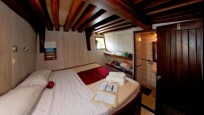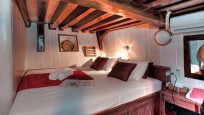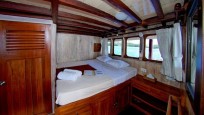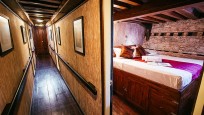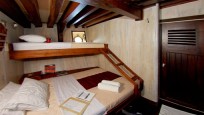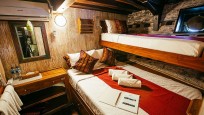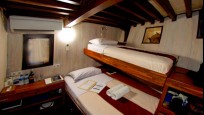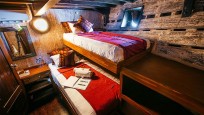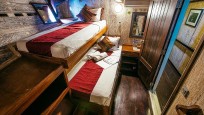The Seven Seas Indonesia
- Nitrox
- PADI
- Camera Station
- Charging Station
- Massage
The Seven Seas is a 45m (LOA), traditionally built Buginese schooner and has set new standards in Indonesian liveaboard luxury. Designed and built by professionals with many years of diving experience in the Indonesian archipelago, Seven Seas is the Liveaboard choice for guests looking for that unforgettable diving holiday anywhere across this vast and unspoiled country. Seven Seas offers year round diving cruises from Bali to Komodo, Raja Ampat, Banda Sea, East of Flores and Forgotten Islands, custom-designed to accommodate up to 16 guests in spacious comfort over three decks she is perfect for both diving and relaxation.
Accommodation
-
1 Double Bed Room
The four double bed rooms are finished to a high standard and come with king size beds. The en-suite bathrooms have powerful hot and cold water showers, hot and cold water wash basins, full sized WC and hairdryer.
-
2 Double and Single Bed Room
The 2 rooms with small double and large single beds in bunk-style are finished to a high standard and come with king size beds. The en-suite bathrooms have powerful hot and cold water showers, hot and cold water wash basins, full sized WC and hairdryer.
-
3 Twin Bed Room
The 2 rooms with large single beds in bunk-style are finished to a high standard and come with king size beds. The en-suite bathrooms have powerful hot and cold water showers, hot and cold water wash basins, full sized WC and hairdryer.
Dining
With many years culinary expertise, the chef prepares truly mouth-watering cuisine. Buffets form the main menu of the day so that we can give you a wider choice and suit the majority of taste buds, including vegetarians. The chef uses as much fresh local produce as she can, including fresh seafood.
The bar has a selection of alcoholic and non-alcoholic drinks. Water, tea and freshly brewed coffee from our espresso machine are included and you can enjoy as much as you like. Your waitresses are happy to help advise you on the full drinks menu. All drinks will be tallied and you will receive the bill at the end of your trip.
Diving
A maximum of 4 dives per day are offered on board: 3 day dives and a night dive, except first and last day and when steaming.
Please note: Diving guests are required to carry a dive insurance such as that provided by DAN and to read and sign Seven Seas Code of Conduct for Divers and Liability Release.
- Free Nitrox
Dive Courses
The Seven Seas offers PADI dive courses and introductory dives.
- PADI Open Water 300$
- PADI Advanced Open Water 200$
- PADI NItrox Course 200$
- PADI Discover Scuba Diving
Equipment Rental
Equipment rental prices are based per day.
- Full set 30$
- Regulator 8$
- BCD 8$
- Wetsuit 8$
- Dive Computer 10$
- Torch 8$
- Snorkeling equipment 8$
Facilities
- Restaurant
- Bar
- Camera Room
- Charging Station
- Camera Rinse Tank
- Air Conditioned Saloon
- Sun Deck
- Shaded Deck Area
- Dive Deck
- Kayaks
- Library
Services
- Daily Housekeeping
- Laundry Service
- Massage
- Audio & Video Entertainment
- Tours
- Kayaks
Activities
A remote perfect beach, visiting a traditional village or a pearl farm, trekking up a hill for a breathtaking view. There is plenty of possibilities for memorable encounters and moments beyond the daily in-water activities. Almost every day we enrich our program to offer the most.
Boat Features & Safety Equipment
| Length | 45 Meters |
| Beam | 8 Meters |
| Engine | Mitsubishi 8M22 450HP V8 |
| Cruising Speed | 8 Knots |
| Water Capacity | 9 Tons per day, 2 freshwater-makers |
| Fuel Capacity | 18 Tons |
| Crew | 18 |
| Passengers | 16 |
| Full Air Conditioning | All rooms and indoor guest areas |
| Entertainment System | DVD, TV, Stereo sound |
| Tenders | 3: 2 x twin-40hp 6.5m fibre boats (center console, taking 6 diving guests each), 1 x inflatable single engine taking 4 diving guests |
| Communication | Iridium Satellite phone, SSB, VHF, SPOT tracker/messenger |
| Navigation | Radar Furono, Sat Nav. Furono, Sounder RayMarine, Back-up GPS plotter: Navman Tracker |
| Safety Equipment | 2 life rafts (20 persons each), 40 adult and 10 infant life jackets, AED (Automated External Defibrillator) |
| Divie Equipment | Twin 9 CFM compressors (Schiffauer), 24 aluminium 12lt tanks, 12 sets rental dive equipment, snorkeling gear, wet suits, Nitrox |
Cruise Price Includes
Accommodation
Transfers from and to the airport or hotel
All meals
Multilingual cruise director on board
Diving services including tanks, weights, fills, guides and dive tenders.
Nitrox fillings for certified enriched air nitrox divers
All offered excursions
All port clearance and conservation fees as well as fuel surcharge are INCLUDED in the price.
Cruise Price Excludes
Pre or post cruise hotels and flights
Dive rental gear
Dive courses
Dive and travel insurance
Crew gratuities
On-board massage
Wine & spirits
Soft drinks
Beer
Laundry services
Use of satellite phone
-
The Komodo National Park
Komodo National Park is a World Heritage site situated in the straits between Sumba and Flores and consists of the three larger islands of Komodo, Rinca and Padar, as well as numerous smaller ones. Because of its unique geology, the islands have developed equally unique wildlife. With dragons on land and a utopia underwater, you will find an array of dive sites and hiking trails to suit every level of experience.
From pristine corals, mantas, sharks, turtles, dolphins, dugong and giant pelagics to tiny pygmy seahorses, nudibranchs and frog fish, you'll find the diversity of marine life inspiring if not mind boggling. The islands feature a dramatic wild savannah landscape with patches of forest especially on the southern hills of Komodo and Rinca. White and red sand beaches, blue lagoons teeming with fish and some of the most spectacular underwater scenery in the world entice divers and guests from around the world.
The underwater topography is as varied as the marine life it homes. Dive sites vary from gentle coral slopes to sheer cliff walls, channels, flat bottoms, pinnacles, caves, swim-throughs and a host of hard and soft corals. From the Flores Sea in the north, the warm waters gradually become cooler as you travel southwards into the Indian Ocean. -
The Deep South of Komodo
Diving the Southern sites of Komodo National Park, and surrounding islands, has always been very exciting and unusual. Rocky canyons and pinnacles are heavily encrusted with marine invertebrate life, with lots of color and plenty of fish. Night diving without a doubt is one of the highlights here, lots of critters and far superior to any of the sites in the north.
During the Northwest Monsoon! From October to May, is the time of the year when the South is the Best! During the Northwest season, everything gets turned around and upside down in Komodo. The waters in the South are clear and warm, and a new underwater world opens up.
What many people don't know is that during the North West Monsoon, between October and May, The south side of the island group completely changes. Conditions in the south improve dramatically as crystal clear currents move into the southern regions of the park, and while the prevailing wind moves from the South East to the North West, the Southern swell calms down, and the cold and murky southern upwelling ceases. This is giving us a great opportunity to focus on a wide variety of southern sites that would hardly be accessible during the other months of the year.
During our Deep South voyages we will be visiting all our currently known high class sites down South, but on top of that you're invited to join in the further exploration of new and promising areas that have already produced mind blowing dives for us over the years. We will visit all the well known world class sites such as Manta Alley, Cannibal Rock, Torpedo Point, The Three Sisters, Lankoi, etc. - plus many new and exciting sites all across the Southern territory and halfway up into the straits (such as Rainbow Reef, Indihiang Island, Batu Tiga and the mantas at Karang Makassar which aggregate there during this time of year). We will not be surrounded by many other boats on these cruises, and that is something which is probably as important to us as it is for you.
Our new itineraries in the Deep South of Komodo will explore the Southern Sape Strait and all around South Komodo, South Rinca, South West Flores, Gili Mota and the Southern part of Selat Molo. Without a doubt some of the world's most unusual tropical diving. We have discovered some very pristine and never visited world class sites in this area and are looking forward to continue the exploration of the south side with you in the next couple of years. Come and see the south as you've never seen it before!
The right conditions await us on our new itineraries down South. This is where we have filmed everything from the largest living animal in the world, the elusive Blue Whale, all the way down the food chain, via great fish life and vibrantly colored reefs created by orange and green cup corals, to soft coral heavens and the most unusual critters hidden in the black sand of volcanic islands that continue to re-create Indonesia's Ring of fire. -
Raja Ampat and Triton Bay (Papua)
More than 1500 islands make up the Raja Ampat archipelago off the Bird’s Head of West Papua. These islands and their surrounding coral reefs support the richest tropical marine bio-diversity found anywhere in the world.
The area includes 4.6 million hectares of diverse marine habitats and is home to more than 1,000 species of fish, 700 species of mollusks and some 540 species of hard corals (75% of the world's total!). Larger marine life includes sperm whales, baleen whales and even orcas coming through this area and there are green turtle nesting beaches on the island of Sayang in the North.
No wonder that this ecosystem attracts more and more divers and other tourists and is a focus area for the Indonesian Ministry of Tourism and Culture as well as for the private sector for eco-tourism development. Several resorts are have started up in the Raja Ampat archipelago, but due to the immense size of the area, the large distances between the top sites and the great variety of islands in different parts of this region, a comfortable liveaboard like the Seven Seasis still the very best way to explore Raja Ampat. And the Seven Seas has all the local knowledge and experience to be your number one choice for this adventure.
Some of the highlights of a Raja Ampat cruise with the Seven Seas include the great diving, snorkeling and cave exploring around the rocky islands off South East Misool, the coral reefs of the Fam Island group, the fish and manta rays of the Dampier straight, the critter diving at Batanta and in Aljui Bay, and of course the great karst formations of the Wayag Archipelago up North. Kayaking among the bee hive shaped karst formations in the Wagmab Island chain in the South is nothing short of stunning, and scattered deserted beaches throughout the Raja Ampat islands make for excellent sunset hideaways. Village visits are unique throughout this region, birds of Paradise can been seen at various locations, and an enormously extended Atoll can be found around Ayau Island in Pacific waters in the far North. Of course, for the real adventurers willing to explore this vast archipelago, there are many islands and reefs still unexplored and many new highlights yet to be discovered... -
Banda Sea and Halmahera
Once sought by Columbus and Marco Polo, the Banda Islands were the original Spice Islands and the most coveted destination on earth, particularly by the Dutch and Portuguese who colonized the islands and exported the indigenous nutmeg and cloves. History tells of a violent past under colonial rule. Now, the seas around these tropical paradise islands are coveted for their spectacular diving and snorkelling on some of the world's richest reefs, unspoiled corals, and large pelagic fish.
Steep drop offs, impressive hard coral and some fast currents make this area absolutely breathtaking. Schools of jacks are a familiar sight, as are large tuna, many turtles, Napoleon wrasse, groupers, rays, sharks and large lobsters. Great visibility is a blessing here, and there are also some special critter sites.
The Banda Sea is surrounded by islands from the large islands of Buru, Halmahera, Ambon and Seram in the north towards Gorom, Kei and Aru in the east, the islands of Tanimbar, Wetar and Reong, and a series of smaller islands such as Babar and Moa, touching East Timor in the south. Ambon Bay is host to some of Indonesia's best critter diving. The nearby island of Halmahera is still largely unexplored and has recently produced some stunning sites.
Gunung Api is an isolated volcanic peak rising from the heart of the Banda Sea. Surrounded by crystal clear waters this uninhabited island is home to thousands of nesting seabirds. Exuding sulphur both above and below the landmark, the water is also home to extraordinary numbers of banded kraits (sea snakes), which have become a special attraction for divers. It's not unusual to have swarms of these non-aggressive sea snakes around you while diving on Gunung Api. -
East of Flores
Unspoiled, remote, yet bewitchingly accessible aboard The Seven Seas, the 2 dozen islands East of Flores are now recognized as one of Asia's top ten dive destinations. This area ranges from the Eastern tip of Flores itself, in the West, via the islands of Adunara, Solor, Lembata and Pantar, plus numerous smaller islands in between, to the Island of Alor in the East of the Nusa Tenggara Timor island chain. Not only World Class muck diving in Lembata and Pantar, not only the classical walls and coral reefs that made this area famous, but now also plenty of high voltage diving on rocky corners, islets and pinnacles along the Southern shores and in the straits between these islands.
Highly diverse habitats, with hard coral dominated reefs, pinnacles and walls covered in combinations of hard and soft corals and other invertebrates, various types of sandy habitats (volcanic black, reef white), sea grass beds and even some blue water mangroves! Great fish life on some of the rocky pinnacles and promontories in the South as well as on some of the new reef and wall dives that we have explored in the North. Last but not least some of the very best cetacean diversity and abundance all around and right through this area which forms a migrating and feeding area for several great whales (notably sperm and blue whales) as well as a preferred habitat from many species of dolphins that occur here in staggering numbers. This area like no other lends itself beautifully for a day of whale watching, whether that is close inshore around the deep volcanic slopes in search of blue whales or out wide where the sperm whales are diving! Too much to do and see but do take the time also for some cultural trips in these remote and interesting islands, with arguable the most stunning volcanic scenery that the entire Coral Triangle has to offer.
The straits in the area play an important role in the exchange of marine life between the Indian and Pacific Ocean. Each year whales and dolphins travel from the Pacific and Indian Oceans through the deep but narrow Nusa Tenggara island chain, which has been identified as an important migration route for numerous whale species as well and great schools of tuna. Massive blue whales also frequently visit here and sometimes spend time resting in Kalebahi Bay in Alor. Coastal communities living along eastern Indonesia's marine migratory routes, especially in the villages of Lamalera and Lamakera, have been hunting whales for centuries. Equipped with simple spears, they take only what their village needs to eat and barter in return for vegetables and rice.
The area offers without a doubt the most complete all round adventure cruise experience that Indonesia has to offer. From the breathtaking erupting volcano of Komba with a fireworks display at night that has to be seen to be believed, to spectacular tranquil lagoon anchorages surrounded by towering volcanoes. The simple villages and the friendly, welcoming people make cruising in this area a great experience for all who are open to take it in. -
Indonesia's Forgotten Islands
Indonesia's "Forgotten Islands" - also known as the Southeast Moluccas (Maluku Tenggara), are not a single destination, but rather a 1,000 km long chain of archipelagos stretching from Timor to West Papua on the island of New Guinea. Undeveloped, distant from population centers and far off any beaten path, these "Forgotten Islands" have been largely isolated from the rest of Indonesia and the world.
The terrain of these islands varies from forested mountainous peaks in the Inner Banda Arc of islands (Wetar, Roma, Damar, Nila), with peaks as high as 868 m (on Damer) to essentially flat islands of the easternmost Aru and Kei island groups, dominated by savannah, mangroves and broadleaf forests.
Together, the islands of Maluku Tenggara make up the eastern end of the bio-geographic province of Wallacea, a transitional region between continental Southeast Asia and Australia-New Guinea, with flora and fauna of the easternmost islands the most similar to New Guinea.
Culturally, most of the Austronesian peoples of the islands of Maluku Tenggara appear to be closely related, sharing similar languages, myths, and traditional beliefs. They are known for their powerful woodcarvings and sculptures depicting ancestral figures, distinctive hand woven ikat fabrics, and plaited bamboo and palm baskets.
The Forgotten Islands offer some of the best diving in Indonesian waters. Attractions include gin-clear waters, patch reefs and coral bommies, spectacular wall dives on impossible drop-offs.
On our inaugural trips to the Forgotten Islands in 2010, our excited visitors enjoyed seeing rare Weedy, Bumphead parrotfish, Jacks (Big-eye trevallies), Giant trevallies, Spanish mackerel, schooling barracuda, hammerhead sharks, a 3 meter salt water crocodile, and a whale shark!
Since 2012 we are offering two expeditions to the Forgotten Islands each year in November/December. One trip starts in Maumere (Flores) or Kupang (West Timor) and ends in Saumlaki, in the Tanimbar Islands, and another trip returns along the same or a similar route. Detailed itineraries in this area will vary according to weather and diving conditions and other factors. But a typical journey through this region might include:
-P. Lembata, a traditional whaling island, which usually offers spectacular critters dives
-Solor/Alor archipelagos. Stops in these islands can include P. Pantar, P. Buaya, P. Alor, Kalabahi)
-P. Komba, location of the Batu Tara volcano.
-P. Wetar. The people of this island live in harmony with salt water crocodiles!
-Barat Daya Islands (P. Romang, P. Nyata, P. Kital, P. Laut, P. Telang)
-Leti island group (P. Leti, P. Lakor, P. Moa)
-Sermata Group (P. Sermata, P. Luang) P. Sermata is known for the many surviving myths that are still part of Forgotten Islands -traditional culture.
-Babar Islands (P. Dai, etc.) These islands are known for the survival of boat symbolism.
-Tanimbar Islands -
Wakatobi National Park
Also known as the Tukang Besi Archipelago, the Wakatobi Marine National Park is the second largest Marine Park in Indonesia. Its four main islands of Wangi-Wangi, Kaledupa, Tomia and Binongko each lend the first two letters of their names to give the area its name.
Fast attracting a reputation as one of the top dive spots in the world, it's hardly surprising as the islands enjoy some of the healthiest coral reefs you are likely to dive. Wakatobi has the largest atoll in the world (Kaledupa), which is home to some of the most bio-diverse marine life in the world. Dolphins, manta rays, whales, turtles, hammerhead sharks, whale sharks and dugongs can all be found here.
Especially the small outer Islands, with their colonies of nesting seabirds and steep drop-offs for fantastic wall diving, will bring you eye to eye with some impressive schools of fish and some massive dogtooth tuna.











